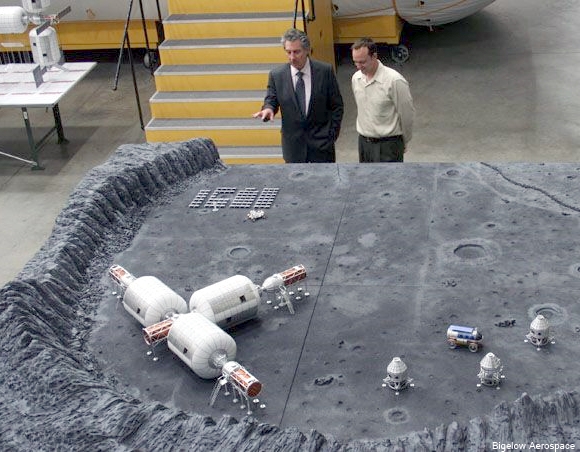 |
| Robert Bigelow explains his moon base concept. Photograph by Bigelow Aerospace. HT: Astronwright ("Chronicles of someone trying to get off this rock.") |
Las Vegas City Life
Business deals don’t get much bigger than this one. Have you ever read a contract that gives a governmental green light to a program to “place a base on the surface of the moon?” Ever see an agreement signed by the U.S. government that declares a specific goal “to extend and sustain human activities across the solar system?” Me, either.
Yet that is essence of an adventurous deal already reached between NASA and Las Vegas space entrepreneur Robert Bigelow. An official announcement is still a few days away and will likely happen during a news conference at NASA headquarters. In the meantime, I have a draft copy of what could be an historic contract, one that reads like a Kubrick screenplay or an Arthur C. Clarke story. It is flat-out otherworldly.
Bigelow made his fortune building apartment buildings and weekly-rental hotel rooms in Las Vegas. In 1999, he launched what must have seemed a pipe dream at the time — his own private space program. But within a few short years he stunned the aerospace world by launching two of his own locally built spacecraft, both of which still circle the Earth (and one of which contains my weightless, floating business card). The focus of Bigelow Aerospace is an expandable module, small and light enough to make for less expensive launches but so strong and durable when expanded to full size that it accomplishes what NASA has been unable to do on its own: It puts more space in space, that is, more room for companies and governments to work, live and conduct research.
Back in January, NASA bigwigs came to Bigelow’s main plant to announce a landmark deal that calls for one of Bigelow’s modules to be attached to the International Space Station (ISS) within two years. Bigelow used that occasion to let slip some even bigger news — the fact that he is spending $250 million of his own money to build a private space station, larger than the ISS, and that he plans to have it in low-Earth orbit by 2016. What few knew at the time was that he was secretly negotiating an even bigger deal with NASA, one that represents a fundamental, across-the-board change in our approach to space.
Read the full article HERE.

No comments:
Post a Comment